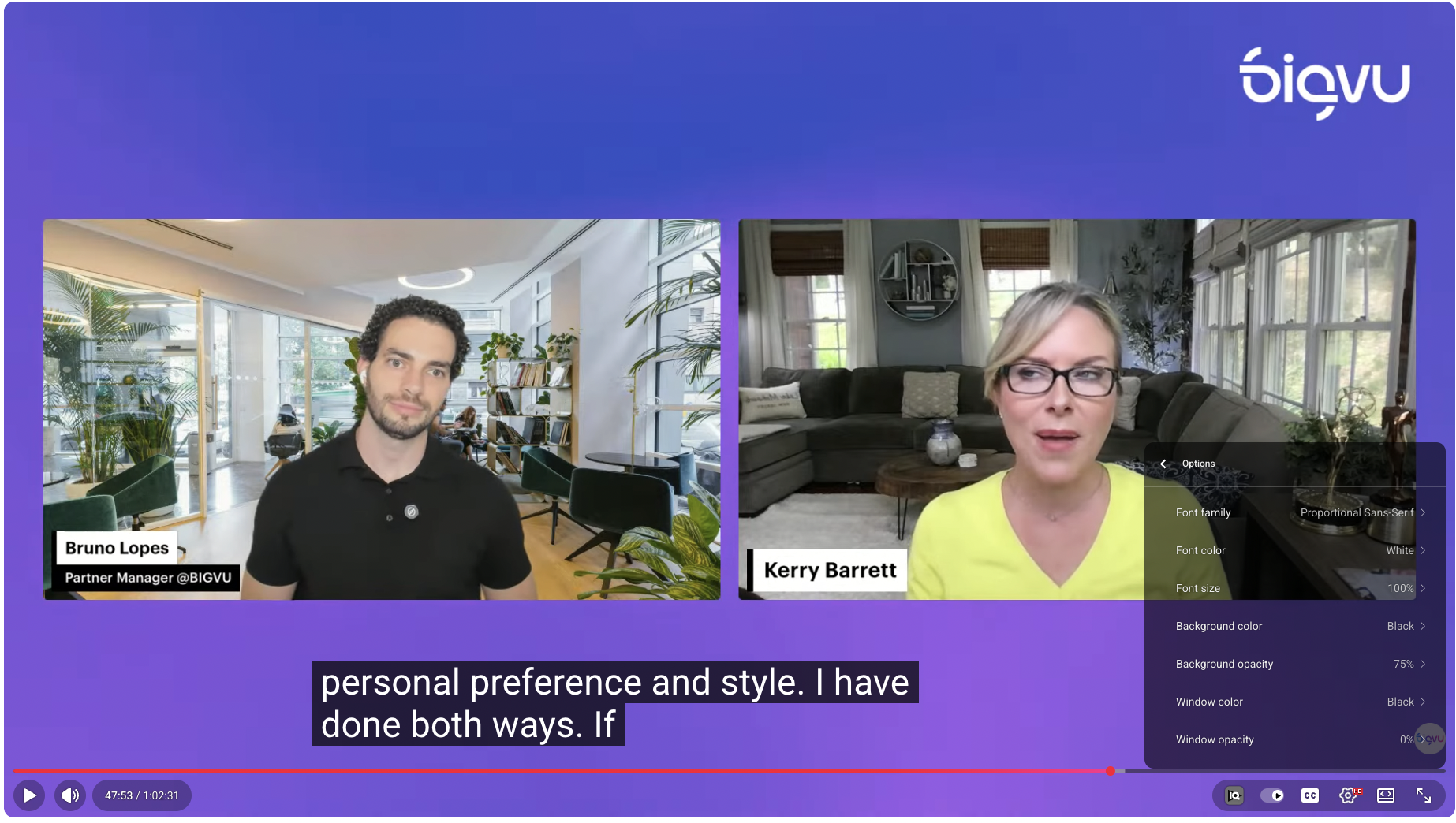What are Open Captions?
So, what does open caption mean? Open captions refer to text that is permanently embedded into the video — viewers cannot turn them off, making them always visible across all platforms.
Unlike closed captions, they can’t be turned on or off — they’re always visible on screen.
What Does Open Caption Mean?
Open captions display both spoken dialogue and important audio cues (like sound effects or background noise), helping viewers understand the content even with the sound off.
In today’s social media landscape, open captions have become essential. According to recent data, 74% of Facebook videos are watched on mute. That means if your video starts playing silently, captions might be the only thing convincing someone to keep watching.
Here’s why open captions are widely used by creators and marketers:
- They ensure your message is seen, even when the sound is off
- They’re ideal for platforms like Instagram Reels, TikTok, and YouTube Shorts
- They boost watch time and engagement by keeping your audience hooked
Whether you're creating short-form content or running video ads, open captions can help your content grab attention — and hold it.
What are Closed Captions?
Closed captions are text versions of the spoken parts in a video, along with background sounds and sound effects. They are primarily designed to help viewers who are deaf or hard of hearing — but they also help in noisy environments or when viewers want to watch without sound.
What makes closed captions different is that they can be turned on or off by the viewer. They’re not embedded in the video like open captions — instead, they’re added as a separate file (usually an SRT file) that platforms like YouTube or Facebook can read and display.
You’ll often see closed captions in:
- TV shows and movies
- Long YouTube videos
- Online courses and educational content
To use closed captions, you need to upload your video along with an SRT file. This text-based file tells the platform what words to display and when.
And here’s a bonus: closed captions also help with video SEO.
When you upload an SRT file to YouTube, the platform can actually read the text — making your video easier to discover for relevant search terms.
For example, we searched for ‘how to add captions in video’ on YouTube and got this result at the top.

This video appeared at the top because we not only optimized its title and description but also uploaded its SRT file on YouTube. That helped YouTube understand this video and show it to us when we searched for it.
Here’s that video:
Many people mistakenly believe that closed captions and subtitles are the same, but they are different. Although both provide text on screen, they have distinct purposes.
Subtitles are used to translate or transcribe dialogue for viewers who do not understand the spoken language.
What is The Difference Between Closed and Open Captions?
Closed captions and open captions are two ways to make your videos easily accessible to a wider audience.
Closed captions can be turned on or off by the viewer, while open captions are always visible because they’re embedded in the video.
Closed captions are great for making your videos accessible to everyone, including people who can’t hear properly. The best thing about them is that your viewers can easily turn them on or off. They’re typically used for video streaming, such as Netflix or in movie theaters.
Here’s an example of YouTube where you can turn on or off the captions with the help of the ‘CC’ button. The ‘CC’ stands for Closed Captions.
Open captions are different because they always appear on the screen, which is awesome for social media, since videos on TikTok or Instagram usually start playing without sound. They can’t be turned off and always roll up on the screen as you speak.
They’re great for making your videos visually appealing to your audience and increasing their views and engagement.
Here’s an example of how open captions look in videos:
Closed Caption Vs Open Caption- Key Differences
Let’s take a closer look at the key differences between closed and open captions to understand which option best fits your video strategy.
This comparison helps clarify what is the difference between open caption and closed caption, making it easier to choose the right format for your audience and goals.
When to Use Open Captions?
You should use open captions when you’re creating advertisement videos for social media or when your videos are displayed in public places like airports, train stations, or waiting rooms where sound is often muted.
The primary role of your video ads is to hook your audience, and well-designed open captions do this well.
Second, most users watch videos on platforms like Facebook, Instagram, and Twitter with the sound off. So with open captions, your message in your Instagram Reel, YouTube Shorts or a TikTok video is still communicated to your audience even if the video is on mute.
How Do Open Captions Appear on Different Social Media Platforms?
Here’s how stunning open captions look on Instagram reels or videos-
YouTube
For YouTube, you can create open captions for both regular videos and Shorts. Here’s how it will look on YouTube Shorts.

When to Use Closed Captions?
As a video creator, use closed captions, especially for making long explainer or how-to videos for YouTube.
This will help with SEO and rank your videos higher in YouTube search results.

How Do Closed Captions Appear on Different Social Media Platforms?
Instagram and Facebook
Instagram has a significant feature of adding auto-generated captions to your videos. When you enable this feature, your viewers can easily toggle closed captions on or off depending on their situation.

This same feature works on Facebook too.
YouTube
Like Instagram and Facebook, YouTube also gives the option of enabling or disabling the closed captions feature. Here’s how closed captions look on YouTube:

As you can see, YouTube offers flexibility to change the font family, color, size, and many other options, allowing viewers to easily customize it.
How to Create Open Captions ?
You can create 100% accurate and stunning open captions with BIGVU with just one tap.
Let’s see how
Step 1: Import Your Video or Record with BIGVU Teleprompter
Import your video directly to BIGVU or use our free teleprompter to record it.
Step 2: Choose Your Language and Open BIGVU Video Maker
In the next step, choose the language for your captions. Then, open BIGVU Video Maker to add captions and style your video.

Step 3: Fix Your Captions with AI
Although captions generated by BIGVU are almost accurate, we always suggest going through them once to fix any typos.

In fact, save time fixing typos with our AI Autofix feature.
Step 4- Style Them to Appeal Your Audience
Next, style your captions by choosing from various themes, colors, and animations to make them look marvelous and visually appealing to hook your viewers within the first few seconds.

Now, click on the ‘Create’ button to create and download your video with good-looking open captions.
How to Create100% Accurate and Automatic Closed Captions with BIGVU (Download SRT File Tool)?
Whether you’re a beginner with zero editing knowledge or a professional creator who wants to produce the highest quality videos, BIGVU lets you easily create and download SRT files and upload them to different social media platforms as closed captions.
Step 1: Import Your Video or Record with BIGVU Teleprompter
First, import your video directly to BIGVU, or record it using our free teleprompter. The advantage of using the BIGVU teleprompter is that you can read your script without memorizing it and record while maintaining eye contact with the camera.

Step 2: Select the Captions Language
In the next step, select the language in which you want your captions to appear.

Step 3: Download the SRT File
Open the video and click ‘Download SRT’ to download the SRT file. You can also translate it into other languages so that there’s no language barrier for viewers.

And that’s it...
In just three steps, you can create and download SRT files and then simply upload them to any social media platform for closed captions.
Frequently Asked Questions
What is the difference between open captions and closed captions?
Open captions are permanently visible on the video, while closed captions can be turned on or off by the viewer.
What does open captioning mean?
Open captioning means the text is burned into the video and always visible — viewers can’t disable it.
What are open captions used for?
Open captions are best for social media videos, ads, or public displays where sound may be off and you need to grab attention visually.
Can caption impact user engagement and watch time on videos?
Yes, captions can enhance user engagement by making the content more accessible and engaging. They can also help stick viewers to your videos, who may otherwise click away because of language barriers or noisy environments.
Which is better for SEO: open or closed captions?
Closed captions are the winner for Search Engine Optimization. Because they are text files, search engines like Google and YouTube can "read" the content of your video, indexing your keywords. Open captions are just images to a search engine, so they don't directly contribute to SEO rankings.
What does "burned-in" captions mean?
"Burned-in" is a synonym for open captions. It means the text has been rendered as part of the video image itself. Just like a logo or a watermark, it is a permanent part of the visual file. This ensures your branding and font choices remain consistent across every device.
Can I use both open and closed captions?
Technically, yes, but it is rarely recommended to use them simultaneously on the same platform because the text will overlap, creating a messy, unreadable experience. However, a smart strategy is to use open captions for your social media clips (Instagram, TikTok) and closed captions for the full-length version on YouTube.
Are open captions accessible?
Yes, but with limitations. Open captions make content accessible to those watching without sound or who are hard of hearing. However, because the viewer cannot resize them or change the contrast, they may not meet strict ADA (Americans with Disabilities Act) standards for users with visual impairments who use screen readers.
How do captions help with social media engagement?
Captions stop the scroll. Since platforms like Facebook and Instagram often autoplay videos on mute, open captions act as a hook, allowing viewers to understand the context immediately. Studies show that captioned videos keep viewers watching significantly longer than non-captioned ones.
Do open captions lower video quality?
If not exported correctly, they can. Because the text is part of the image, if you compress the video file too much, the text can become pixelated or blurry. To avoid this, always use high-resolution export settings when using an AI subtitle generator to ensure crisp, readable text.
What formats are used for closed captions?
The most common format for closed captions is .SRT (SubRip Subtitle). It is widely supported by YouTube, Facebook, LinkedIn, and Vimeo. Other formats include .VTT (WebVTT) and .SCC (Scenarist Closed Caption), which are often used in broadcast or specific streaming environments.
Comparison: Open vs. Closed Captions
Conclusion
Deciding between open and closed captions doesn't have to be a headache. It simply comes down to your goal: use open captions to stop the scroll and build your brand on social media, and use closed captions to boost your SEO and accessibility on search engines like YouTube.
You don't need to be a tech wizard to get this right. With tools like the BIGVU teleprompter app, you can record your script with confidence, maintain eye contact, and then instantly generate stylish open captions with a single click. Stop worrying about the technical details and start creating content that connects. Your audience is waiting—and now, they’ll actually hear what you have to say.






